 |  |











 |
Bird-safe Buildings
Follow these guidelines to make your building or residence safer for birds!
Chicago Bird Collision Monitors' Best Practices for a Bird-Friendly Buildings:
(Modified from City of Toronto's rating system)
- Glass treatment
Extent of glass treatment applications that will block a bird's view of the interior of a building:
Minimum
- Treat first 10 feet of these selected high danger areas:
- Lobbies/atriums with interior lighting at night/early morning hours
- Lobbies/atriums with interior greenery that is visible from the outside
- Glass that is proximal to external greenery
- Areas that trap birds between two or three sides of glass/windows such as an alley, alcove, corner of a building, area above a skylight/atrium, etc.
- Glass "passageways" that appear to be areas birds could fly through to vegetation/open space on either side
Desired
- Treat all areas of glass up to 10 feet above grade
- Optimal/Best Practice
- Treat glass for entire building
Type of glass treatment/design:
Minimum
- During designated spring and fall migration season implement temporary treatment of transparent glass with decals, paints, films at a density pattern of three inches or less apart; strategies to mute reflections with external screening/netting, banners, paints, films
Desired
- Permanent treatment of transparent glass with UV coatings/films or frosted/fritted patterns using a density pattern of three inches or less apart; strategies to mute reflections such as angled glass, external screening/netting or awnings
Optimal/Best Practice
- Use frosted/fritted or bird-safety glass!
Ê
- Exterior lighting
Minimum
- Extinguish or dim display lighting, including spotlighting, decorative, advertising and rooftop lighting, on buildings over 40 stories from 11:00 p.m. until sunrise during designated spring and fall migration periods
Desired
- Efficient shield lighting installed for all exterior lighting fixtures, including decorative, advertising and security lighting, focusing light downward eliminating direct upward light and reducing spill light
Optimal/Best Practice
- Display lighting, including spotlighting, decorative, advertising and rooftop lighting, eliminated
- Building Operations
Interior greenery
Minimum
- Internal greenery located at least 10 feet away from glass without treatment
Desired
- All internal greenery that could be visible from outside shielded or removed during designated spring and fall migration season
Optimal/Best Practice
- No interior greenery that could be visible from outside or glass treated with density pattern of less than 3 inches apart to shield view of interior greenery
Interior Lighting (particularly for ground level lobby areas)
Minimum
- Motion sensor lighting or light timers in link ways, walkways and corridors; zone capable interior lighting system
Desired
- Minimize total amount of interior lighting using task lighting, blinds, light switches and motion sensor lights in individual offices; cleaning operations during daylight hours
Optimal/Best Practice
- Eliminate ground level lobby lighting providing only lighting directed to workstations and security areas
- Site Design
Minimum
- Drain any pools/fountains that are directly below a set of windows/glass surfaces during migration season; Ground level ventilation grates with a porosity of less than 1 inch X 1 inch
Desired
- All ventilation opening grates proximal to windows capped
Optimal/Best Practice
- No pools, fountains, ground level ventilation grates within five feet of windows/glass surfaces
Examples of Bird-Safe building practices:
Lobby lights that are turned off or dimmed in the early morning hours prevent window strikes. If birds cannot see interior plants or fountains they will not fly into glass trying to reach an area that looks safe and inviting.

Visible interior plantings vs. Darkened interior
Temporary or permanent installation of netting/screens secured on the outside of dangerous reflective or transparent glass will make a safe barrier that stops birds from colliding. The netting has minimal effect on the view from the inside. This can be a simple, unobtrusive and easily removable solution that saves hundreds of bird lives. The Chicago Botanic Gardens worked with CBCM and adopted using this very effective bird protection technique every migration season.

Chicago Botanic Gardens, Glencoe, IL (inside and outside photo)
In 2008 the Chicago Federal Bureau of Investigation facility received the LEED's Platinum Certification for Energy & Environmental Design for Existing Buildings (EBOM). They went beyond these standards to add bird safety measures at their main lobby area. In previous years, the transparent glass and inviting interior landscaping resulted in hundreds of bird strikes during spring and fall migration. After working with Chicago Bird Collision Monitors, the facility installed netting that has significantly reduced bird collisions at this location. Thank you for making this building an even better example of green design!!!
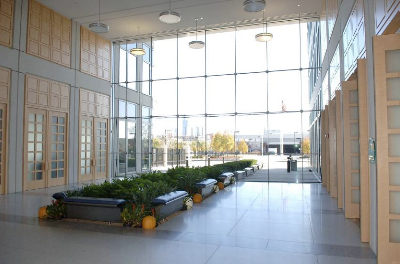
Transparent lobby glass and continuous interior/exterior landscaping is a lethal hazard for birds that cannot perceive a barrier between the inside and outside areas.
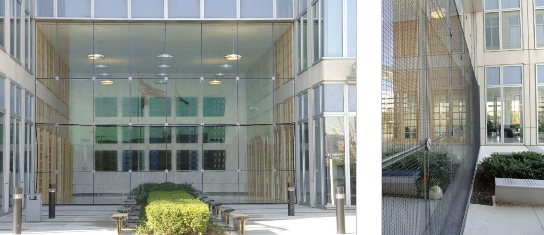
Netted exterior prevents bird strikes.
Installing perforated window film on exterior glass surfaces can block a bird's view of a lobby landscaping.

From the outside, strips of CollidEscape window film block birds' view of a tree inside the lobby. On the inside, the CollidEscape allows light to enter and does not obstruct the view out the windows.
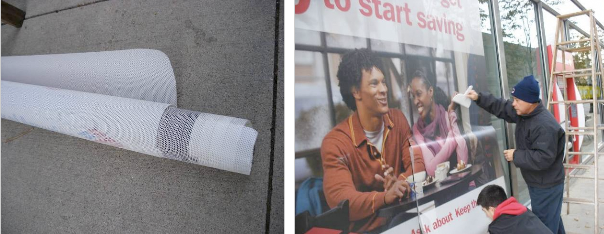
Window films can be decorative or advertisements.
Painting temporary window murals decreases the reflectivity and transparency of glass. Artists and school children participated in glass painting projects that made windows safer for migratory birds.
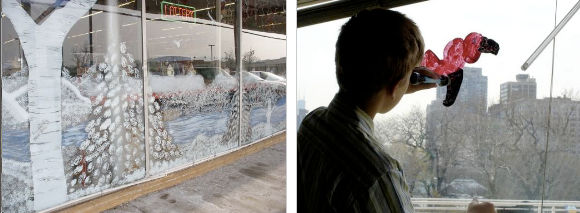
Interior curtains or screens can block glass transparency and reduce some reflection.
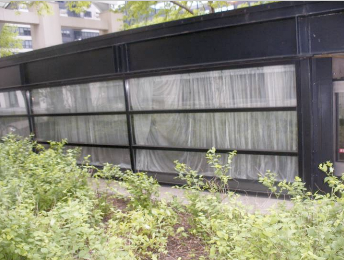
Chicago Amtrak Station: curtains block clear glass that would seem an open passage between two areas of outside plantings.
Interior blinds/screens block views of plants inside a lobby.
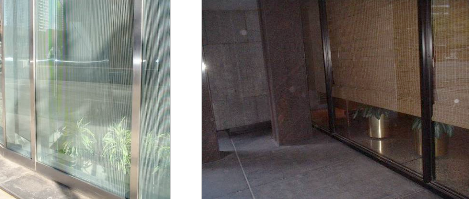
Interior blinds/screens block views of plants inside a lobby.
Wind socks, banners, decals, blinds, hanging decorations placed on the outside (ideally) or inside of an area with transparent glass can block a bird's view into a building and its attempts to fly through what it would otherwise see as open space.
Students and teachers at the Akiba Schechter school in Hyde Park collaborated with Chicago Bird Collision Monitors to create bird banners that block the transparency of a clear glass passageway between buildings that had previously been a deadly hazard for birds.
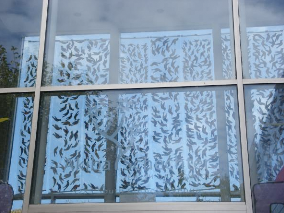
Angled and fritted/frosted glass minimizes hazards of reflective and transparent surfaces. Glass that angles downward has less reflection of sky and trees. Frosted or fritted glass brings light into a building without dangerous transparency.
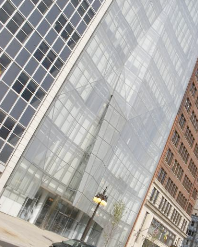
Spertus Institute of Jewish Studies 610 South Michigan Avenue, Chicago, IL
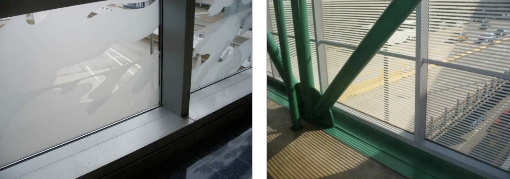
Frosted glass on airport link ways
Window/glass films that duplicate a fritted glass treatment were applied to make clear glass doors less dangerous for birds at Chicago's Blue Cross Blue Shield Building. CBCM helps buildings identify areas that are dangerous for birds and reduce hazards.

Glass lobby retrofitted with patterned window film to reduce bird collisions. Convenience Group Inc., a certified 3M dealer and applicator of window film solutions completed this successful Canadian project. Article.
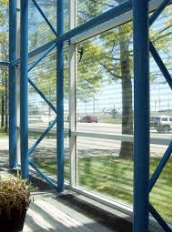
8100 Warden Ave, Markham, Ontario, Canada
Innovative building design that eliminates the appearance of large, uninterrupted surfaces of transparent or reflective glass by creating "visual noise" or noticeable surface areas that birds will not try to fly into or through.
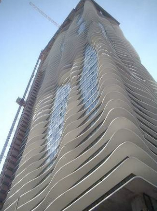
Aqua Tower, Chicago, IL Studio Gang Architects
Contact CBCM to learn ways to improve bird safety at your building:
(773) 988-1867 or email us: info@birdmonitors.net
Chicago Bird Collision Monitors (CBCM) is an all volunteer bird conservation project that operates under the auspices of the Chicago Audubon Society.
Home * Contact Us * FAQ
Copyright 2012 Chicago Bird Collision Monitors
| |
|